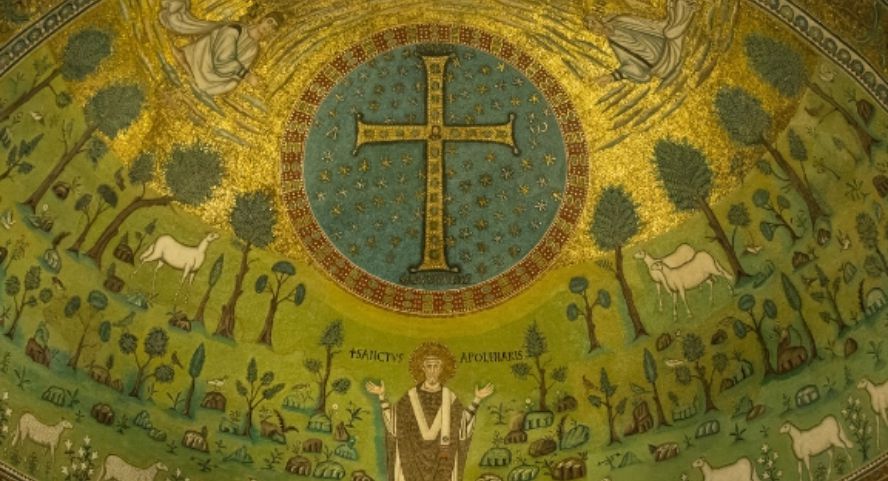Animals in the Symbolic Interpretation of the Eucherius of Lyon’s "Formulae spiritalis intellegentiae"
Tomasz Skibiński
Cardinal Stefan Wyszyński University in Warsaw , Polandhttps://orcid.org/0000-0001-5509-0865
Abstract
The subject of this article is the analysis of the symbolic interpretation of animals as presented by Eucherius of Lyon in his work Formulae spiritalis intellegenatiae. The article examines Eucherius’s interests and knowledge in the field of symbolic interpretation of animals, the sources he used, and the content of his interpretation. The primary source of the research are Formulae spiritalis intellegentiae, which is compared primarily with another exegetical work, Instructiones. The research reveals that Eucherius possesses a fundamentally good knowledge of biblical animals, largely indebted to the sources he utilized. His interpretation addresses several fundamental themes: theological issues, where the author interprets animals as symbols of Christ, the Holy Spirit, or, in opposition, the devil (demons, idols). Anthropological interpretations are also frequent, wherein animals symbolize people judged positively or negatively for moral or doctrinal reasons. Animals can also symbolize Scripture and types of its interpretation. Eucherius’s works are addressed to his sons, Salonius and Veranius, who later became bishops. The works were also intended for a wider audience, and it is evident that Eucherius assumed a certain level of proficiency and familiarity with the Holy Scripture and its interpretation among his readers, hence he did not see the need to provide overly detailed or fundamental explanations.
Keywords:
Eucherius of Lyon, exegesis, animal, symbolism, BibleReferences
Ambrosius Mediolanensis, Expositio Evangelii secundum Lucam, ed. M. Adriaen, CCL 14, Turnhout 1957.
Ambroży z Mediolanu, Wykład Ewangelii według św. Łukasza, tł. W. Szołdrski, PSP 16, Warszawa 1977.
Animali simbolici. Alle origini del bestiario cristiano, t. 1-2, ed. M.P. Ciccarese, Biblioteca Patristica 39, 44, Bologna 2002-2007.
Caius Plinius Secundus, Naturalis historiae libri XXXVII, post Ludovici Iani obitum recognovit et scripturae discrepantia adiecta edidit Carolus Mayhoff, t. 2: Libri VII-XI, Lipsiae 1906.
Gajusz Pliniusz Sekundus, Historia Naturalna (wydanie dwujęzyczne); t. 2: Antropologia i Zoologia, Księgi VII-XI, tł. I. Mikołajczyk, Toruń 2019.
Eucherius Lugdunensis, Formulae spiritalis intellegentiae, w: Eucher de Lyon, Œuvres exégétiques. Clés pour l’intelligence spirituelle. Instructions , ed. M. Dulaey, Sources Chrétiennes 618, Paris 2021, s. 92-259.
Eucheriusz z Lyonu, Dzieła egzegetyczne. Zasady rozumienia duchowego. Wyjaśnienia, tł. i red. T. Skibiński, PSP 84, Warszawa 2023.
Eucherius Lugdunensis, Instructionum libri duo, w: Eucher de Lyon, Œuvres exégétiques. Clés pour l’intelligence spirituelle. Instructions , ed. M. Dulaey, Sources Chrétiennes 618, Paris 2021, s. 260-561.
Bardski K., Chrześcijańska lektura Starego Testamentu w kluczu symboliki literackiej, „Rocznik Teologiczny” 57/4 (2015) s. 447-457.
Bosak P.C., Leksykon wszystkich zwierząt biblijnych. Słownik – konkordancja, Kraków 2018.
Ciccarese M.P., „Formam Christi genere”. Osservazioni sul simbolismo cristologico degli animali, „Annali di Storia dell’Esegesi” 8/2 (1991) s. 565-587.
Ciccarese M.P., Bibbia, bestie e Bestiari: l’interpretazione cristiana degli animali dalle origini al Medioevo, w: Animali tra mito e simbolo, ed. A.M.G. Capomacchia, Roma 2009, s. 73-124.
Ciccarese M.P., Il simbolismo antropologico degli animali nell’esegesi cristiana antica. Criteri e contenuti ermeneutici, „Annali di Storia dell’Esegesi” 7 (1990) s. 529-567.
Couto-Ferreira M.E. (rec.), Animali tra mito e simbolo, ed. Anna Maria Gloria Capomacchia, Roma, Carocci, 2009, pp. 126, „Rivista degli studi orientali. Nuova Serie” 83/4 (2010) s. 455-460.
Curti C., „Spiritalis intelligentia”. Nota sulla dottrina esegetica di Eucherio di Lione, w: Kerygma und Logos. Beiträge zu den geistesgeschichtlichen Beziehungen zwischen Antike und Christentum: Festschrift für Carl Andresen, red. A.M. Ritter, Göttingen 1979, s. 108-122.
Dulaey M., Eucher exégète: l’interprétation de la Bible en Gaule du Sud dans la première moitié du Ve siècle, w: Mauritius und die thebäische Legion, Saint Maurice et la lé gion thé baine, Actes du colloque de Fribourg, Saint Maurice et Martigny, 478 Les déserts de L’Occident 17-20 septembre 2003 , ed. O. Wermelinger – P. Bruggisser – B. Näf – J.-M. Roessli, Paradosis. Beiträge zur Geschichte der altchristlichen Literatur und Theologie 49, Fribourg 2005, s. 67-93.
Dulaey M., La bibliothèque de Lérins dans les premières dé cennies du IVe s. d’après l’oeuvre d’Eucher de Lyon, „Augustinianum” 46 (2006) s. 187-230.
Elfassi J. (rec.), Isidore de Séville, Étymologies. Livre VII. Dieu, les anges, les saints. Texte é tabli par Jean-Yves Guillaumin, traduit et commenté par Jean-Yves Guillaumin et Pierre Monat, Paris, Les Belles Lettres, 2012 (Auteurs Latins du Moyen Âge), 262 pages, „Archivum Latinitatis Medii Aevi” 72 (2014) s. 410-415.
Elfassi J., Isidore de Séville connaissait-il les Formulae d’Eucher de Lyon?, w: Felici curiositate. Studies in Latin Literature and Textual Criticism from Antiquity to the Twentieth Century. In Honour of Rita Beyers, red. G. Guldentops – Ch. Laes – G. Partoens, Turnhout 2017, s. 377-382.
Jóźwiak M.M., lluminatrix – stella maris – domina? (św. Hieronim). Patrystyczna interpretacja imienia Maria – wybrane hipotezy, „Vox Patrum” 80 (2021) s. 161-176.
Lo Giudice C., L’impiego degli animali negli spettacoli romani: venatio e damnatio ad bestias, „Italies. Litté rature – civilisation – socié té ” 12 (2008) s. 361-395, w: https://doi.org/10.4000/italies.1374 (dostęp: 15.06.2024).
Mandolfo C., Sulla Praefatio programmatica delle Formulae spiritalis intellegentiae e sulla terminologia esegetica di Eucherio di Lione, „Sileno” 38 (2012) s. 151-180.
Mandolfo C., The Exegetical Doctrine of Eucherius Lugdunensis: Theory and Praxis, „Sileno” 41 (2015) s. 231-262.
Merkelbach R., Drache, w: Reallexikon für Antike und Christentum, t. 4, red. E. Dassmann et al., Stuttgart 1959, s. 226-227.
Morta K., Biblijny re’em, „Kaliskie Studia Teologiczne” 1 (2002) s. 145-151.
Morta K., Świat egzotycznych zwierząt u Solinusa, Wrocław 2004.
Morta K., Z badań nad źródłami opisów zwierząt u Solinusa, „Classica Wratislaviensia” 27 (2007) s. 77-88.
Ogden D., Drakōn. Dragon Myth and Serpent Cult in the Greek and Roman Worlds, Oxford 2013.
Pałucki J., Świeccy adresaci listów Paulina z Noli, „Vox Patrum” 42-43 (2002) s. 253-260.
Pintus G.M., Il bestiario del diavolo; l’esegesi biblica nelle „Formulae spiritalis intellegentiae” di Eucherio di Lione, „Sandalion” 12-13 (1989-1990) s. 99-113.
Pochwat J., Specyfika głównych ośrodków życia monastycznego w Galii w IV i V wieku, „Polonia Sacra” 21/3 (2017) s. 107-128.
Pricoco S., Eucherio di Lione, w: Nuovo dizionario patristico e di antichitá cristiane, t. 1, ed. A. Di Berardino, Genova – Milano 2006, k. 1819-1822.
Pricoco S., Lé rins (Lerino) , w: Nuovo dizionario patristico e di antichitá cristiane, t. 2, ed. A. Di Berardino, Genova – Milano 2006, k. 2793-2794.
Skibiński T., Leryn, w: Nowy Słownik Wczesnochrześcijańskiego Piśmiennictwa, red. M. Starowieyski – J.M. Szymusiak, Poznań 2022, s. 653-655.
Skibiński T., Eucheriusz z Lyonu, w: Nowy Słownik Wczesnochrześcijańskiego Piśmiennictwa, red. M. Starowieyski – J.M. Szymusiak, Poznań 2022, s. 318-321.
Skibiński T., L’interpretazione della Scrittura in Eucherio di Lione, Roma 1995.
Skibiński T., Wprowadzenie, w: Eucheriusz z Lyonu, Dzieła egzegetyczne. Zasady rozumienia duchowego. Wyjaśnienia, red. T. Skibiński, Pisma Starochrześcijańskich Pisarzy 84, Warszawa 2023, s. 7-19.
Skibiński T., Zasady interpretacji Pisma św. w świetle Praefatio do Formulae spiritalis intellegentiae Eucheriusza z Lyonu, w: Bóg Ojciec i przełom wieków w myśli patrystycznej, red. I. Salamonowicz-Górska – J. Naumowicz – S. Strękowski, Warszawa 2001, s. 236-255.
Weidmann C., Zwei Weihnachtspredigten des Eucherius von Lyon, w: Edition und Erforschung lateinischer patristischer Texte. 150 Jahre CSEL. Festschrijtfür Kurt Smolak zum 70. Geburtstag, ed. V. Zimmerl-Panagl – L.J. Dorfbauer – C. Weidmann, Berlin 2014, s. 111-138.
Wysocki M., The Symbolism of Biblical Birds in the Letters of Paulinus of Nola, w: The Bible in the Patristic Period, red. M. Szram – M. Wysocki, Studia Patristica 103, Leuven – Paris – Bristol 2021, s. 165-173.
Zalewski D., Idea contemptus mundi u Eucheriusza z Lyonu, „Vox Patrum” 57 (2012) s. 793-805.
Żurek A., „Nawróceni chrześcijanie” – duchowość galijskich arystokratów IV-V wieku, „Vox Patrum” 55 (2010) s. 809-820.
Cardinal Stefan Wyszyński University in Warsaw https://orcid.org/0000-0001-5509-0865
License

This work is licensed under a Creative Commons Attribution-NoDerivatives 4.0 International License.
Papers published in Vox Patrum are covered by the Attribution-NoDerivatives 4.0 International (CC BY-ND 4.0) licence. Authors and users can use published works licensed under the CC-BY-ND since 2018. For earlier publications, copyrights are available under fair use rights in accordance with the Act of February 4, 1994 on copyrights and related rights.







